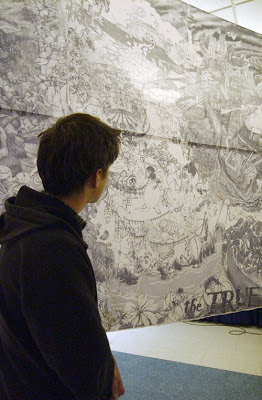Beehive Design Collective share stories of activists
By Sam Schild / April 24, 2009
“Clean Coal Dirty Lie” is a sign held by a depiction of a bee, meant to represent an Appalachian person, in the Beehive Design Collective’s newest collage drawing project: “The True Cost of Coal: Mountaintop Removal and the Fight For Our Future.”
There was much happening on the quad in celebration of Earth day on Wednesday. But somewhere off the quad, the distant sound of bees could be heard. A buzzing could be heard all over campus coming from the activity room of the Bowling and Billiards Center.
While there were not actually any bees in the Bowling and Billiards center, the Beehive Design Collective were creating quite the buzz. With original activist artwork and a presentation related to their newest project, the Bees brought social and environmental activism in the form of giant mural collages.
The Beehive Collective is a group of traveling artists and activists. They go from location to location spreading the messages behind their “anti-copyright” images. This group of 16 Bees work collectively, “as horizontal and non hierarchically as possible,” Tyler Bee said while giving a brief introduction about the Beehive Collective organization.
The Beehive Collective is a not for profit organization. Their collages tell stories that can serve as “an activist’s cheat sheet,” Tyler Bee said.
They take their artwork all over to tell their stories. They take the collages to organic fairs, protests, schools and many other locations, spreading the messages behind each meticulously created collage. Normally, there would be a whole swarm of “bees” with Tyler at an event like the one in the BBC, but for this particular presentation he was alone.
Based out of Machias, Maine, The Beehive Collective spends months, or more often years, creating gigantic murals of our smaller drawings.
“[We] collage and quilt smaller drawings together,” Tyler Bee said. “All the little stories, little projects, little communities all do their parts to create this bigger picture,” Tyler Bee continued, “[We try to] make sense of smaller stories to make a larger narrative.” This is how the Bees’ artwork relates to the world, on a theoretical level.
But, the Bees’ artwork relates to the world on a literal level as well. Past Beehive Collective collages deal with important topics such as globalization, corporate colonization and human rights, to name a few. And with their latest piece, environmental justice can be added to the list of important issues the Beehive collective’s artwork deals with.
In the collages there are no humans depicted, the only living beings in the Bees’ artwork are plants and animals. The Bees use different animals to represent people. They ask groups of people which animal they identify most with, and then use that animal in their drawings to stand in for those people.
“[This way we] avoid really stupid stereotypes of people,” Tyler Bee said, and also this is to serve as a reminder that humans are animals as well.
“The True Cost of Coal” is still unfinished, but even in its work-in-progress form it still struck awe into audience members.
“[The piece is] Really, really cool” Kyle Riley, a freshman history major, said.
The Bees’ latest project and the object of Wednesday’s presentation contained an extraordinary amount of detail. The approximately 5 foot by 12 foot canvas the piece was printed on contained countless individual scenes which each had its own little story.
Each of these scenes was interwoven and flowed seamlessly into the next scene. This makes it so one could find themselves looking at the other end of the collage just after starting to look at the fir end.
“It’s refreshing to get some insight on this issue,” Paul Nolley, a sophomore political science major, said.
Tyler Bee demonstrated how a piece of Beehive Collective artwork can serve as an “activist’s cheat sheet” with the presentation he gave. He told the story of America and its relation to coal.
The collage is separated into five sections, and when it is folded so that only the outside two sections are showing, there is a pleasant picture of the world before coal burning began. Then, the picture “opens up to show how mountain top removal mining rips the environment apart.”
Mountain top removal mining is the modern “mechanized” method of mining coal.
“If the mountain is a layer cake, the coal is the frosting in between layers,” Tyler said.
The mountain is blown up and the coal is scooped out by a machine called a dragline. After each layer of coal is removed, the next layer of rock is blown up and dumped into the valleys in between the mountains.
“There are [at least] 500 mountains no longer in existence [in Appalachia because of mountain top removal mining]” Tyler Bee said.
Mountain top removal mining reduces the amount of manpower needed. Approximately 200 miners are needed using traditional, less environmentally damaging deep mining techniques. But with mountain top removal mining, only 12 people are needed to do the work that previously would have taken 200. Therefore, Tyler Bee said, when coal companies say “coal means jobs for America,” it is a lie.
Mountain top removal is only the tip of the iceberg when it comes to discussing the true cost of coal. Burning coal is just as environmentally degrading, if not more.
“If the world stopped burning coal, this would be 80 percent of the solution to climate change,” Tyler Bee said.
Source / Daily Vidette at Illinois State University



















actually- we’re based in Maine, but can be found all over the place!